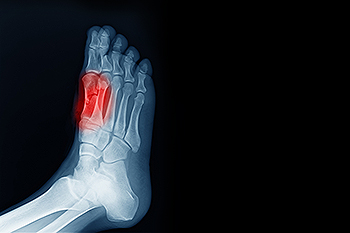
Many athletes, such as runners, and dancers, experience a condition known as sesamoiditis. This is an inflammation of the tendons of two tiny sesamoid bones that lie under the big toe joint. Any activity that transfers weight to the ball of the foot can cause sesamoiditis. Runners with this condition may need help in finding the proper shoes to accommodate this overuse injury. Such a shoe would likely have a wide toe box that allows the toes to spread wider than the ball of the foot. Secondly, it would include what is termed by experts as a zero heel-to-toe drop. In effect, the ball of the foot and heel would be aligned on the same plane. Lastly, the shoe should not have an elevation of the toe box above the ground, which is termed a toe spring. The current industry toe spring standard is 15 degrees. This can increase pressure on the ball of the foot. While it may be difficult to adjust to this type of minimalist running shoe, some people may wish to ease into the change with transition shoes. If you have any questions on how to deal with sesamoiditis and find the shoe that can keep you running, it is suggested that you make an appointment with a podiatrist.
Sesamoiditis is an unpleasant foot condition characterized by pain in the balls of the feet. If you think you’re struggling with sesamoiditis, contact Dr. Steven Shlonsky of Louisville, Kentucky. Dr. Shlonsky will treat your condition thoroughly and effectively.
Sesamoiditis
Sesamoiditis is a condition of the foot that affects the ball of the foot. It is more common in younger people than it is in older people. It can also occur with people who have begun a new exercise program, since their bodies are adjusting to the new physical regimen. Pain may also be caused by the inflammation of tendons surrounding the bones. It is important to seek treatment in its early stages because if you ignore the pain, this condition can lead to more serious problems such as severe irritation and bone fractures.
Causes of Sesamoiditis
- Sudden increase in activity
- Increase in physically strenuous movement without a proper warm up or build up
- Foot structure: those who have smaller, bonier feet or those with a high arch may be more susceptible
Treatment for sesamoiditis is non-invasive and simple. Doctors may recommend a strict rest period where the patient forgoes most physical activity. This will help give the patient time to heal their feet through limited activity. For serious cases, it is best to speak with your doctor to determine a treatment option that will help your specific needs.
If you have any questions please feel free to contact our office located in Louisville, KY . We offer the newest diagnostic and treatment technologies for all your foot and ankle needs.












